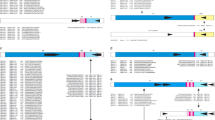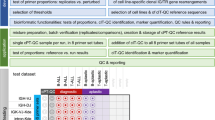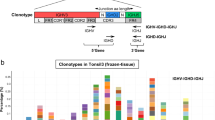Abstract
The BIOMED-2 multiplex polymerase chain reaction (PCR) tubes for analysis of immunoglobulin and T-cell receptor (TCR) gene rearrangements have recently been introduced as a reliable and easy tool for clonality diagnostics in suspected lymphoproliferations. Quality and performance assessment of PCR-based clonality diagnostics is generally performed using human leukemia/lymphoma cell lines as controls. We evaluated the utility of 30 well-defined human T-cell lines for quality performance testing of the BIOMED-2 PCR primers and protocols. The PCR analyses of the TCR loci were backed up by Southern blot analysis. The clonal TCRB, TCRG and TCRD gene rearrangements were analyzed for gene segment usage and for the size and composition of their junctional regions. In 29 out of 30 cell lines, unique clonal TCR gene rearrangements could be easily detected. Besides their usefulness in molecular clonality diagnostics, these cell lines can now be authenticated based on their TCR gene rearrangement profile. This enables their correct use in molecular clonality diagnostics and in other cancer research studies.
This is a preview of subscription content, access via your institution
Access options
Subscribe to this journal
Receive 12 print issues and online access
$259.00 per year
only $21.58 per issue
Buy this article
- Purchase on Springer Link
- Instant access to full article PDF
Prices may be subject to local taxes which are calculated during checkout
Similar content being viewed by others
References
van Dongen JJ, Langerak AW, Bruggemann M, Evans PA, Hummel M, Lavender FL et al. Design and standardization of PCR primers and protocols for detection of clonal immunoglobulin and T-cell receptor gene recombinations in suspect lymphoproliferations: report of the BIOMED-2 Concerted Action BMH4-CT98–3936. Leukemia 2003; 17: 2257–2317.
Sandberg Y, Heule F, Lam K, Lugtenburg PJ, Wolvers-Tettero IL, van Dongen JJ et al. Molecular immunoglobulin/T-cell receptor clonality analysis in cutaneous lymphoproliferations. Experience with the BIOMED-2 standardized polymerase chain reaction protocol. Haematologica 2003; 88: 659–670.
Droese J, Langerak AW, Groenen PJ, Bruggemann M, Neumann P, Wolvers-Tettero IL et al. Validation of BIOMED-2 multiplex PCR tubes for detection of TCRB gene rearrangements in T-cell malignancies. Leukemia 2004; 18: 1531–1538.
McClure RF, Kaur P, Pagel E, Ouillette PD, Holtegaard CE, Treptow CL et al. Validation of immunoglobulin gene rearrangement detection by PCR using commercially available BIOMED-2 primers. Leukemia 2006; 20: 176–179.
Brüggemann M, White H, Gaulard P, Garcia-Sanz R, Gameiro P, Oeschger S et al. Powerful strategy for PCR-based clonality assessment in T-cell malignancies. Report of the BIOMED-2 Concerted Action BHM4 CT98–3936. Leukemia 2007, (in press).
Evans PAS, Pott C, Groenen PJTA, Salles G, Davi F, Berger F et al. Significantly improved PCR-based clonality testing in B-cell malignancies by use of multiple immunoglobulin gene targets Report of the BIOMED-2 Concerted Action BHM4-CT98–3936. Leukemia 2007, (in press).
Sandberg Y, van Gastel-Mol EJ, Verhaaf B, Lam KH, van Dongen JJ, Langerak AW . BIOMED-2 multiplex immunoglobulin/T-cell receptor polymerase chain reaction protocols can reliably replace southern blot analysis in routine clonality diagnostics. J Mol Diagn 2005; 7: 495–503.
Yao R, Rich SA, Schneider E . Validation of sixteen leukemia and lymphoma cell lines as controls for molecular gene rearrangement assays. Clin Chem 2002; 48: 1344–1351.
Chen TR . In situ detection of mycoplasma contamination in cell cultures by fluorescent Hoechst 33258 stain. Exp Cell Res 1977; 104: 255–262.
Roberts WWS, Uribe L, Weinberg K . The ARR cell line: a model of acute leukemias expressing both T lymphoid and myeloid associated genes. Clin Res 1992; 40: 30a.
Kurtzberg J, Bigner SH, Hershfield MS . Establishment of the DU.528 human lymphohemopoietic stem cell line. J Exp Med 1985; 162: 1561–1578.
Pasqualucci L, Wasik M, Teicher BA, Flenghi L, Bolognesi A, Stirpe F et al. Antitumor activity of anti-CD30 immunotoxin (Ber-H2/saporin) in vitro and in severe combined immunodeficiency disease mice xenografted with human CD30+ anaplastic large-cell lymphoma. Blood 1995; 85: 2139–2146.
Smith SD, Morgan R, Link MP, McFall P, Hecht F . Cytogenetic and immunophenotypic analysis of cell lines established from patients with T cell leukemia/lymphoma. Blood 1986; 67: 650–656.
Van Dongen JJ, Wolvers-Tettero IL . Analysis of immunoglobulin and T cell receptor genes. Part I: basic and technical aspects. Clin Chim Acta 1991; 198: 1–91.
Langerak AW, Wolvers-Tettero IL, van Dongen JJ . Detection of T cell receptor beta (TCRB) gene rearrangement patterns in T cell malignancies by Southern blot analysis. Leukemia 1999; 13: 965–974.
Moreau EJ, Langerak AW, van Gastel-Mol EJ, Wolvers-Tettero IL, Zhan M, Zhou Q et al. Easy detection of all T cell receptor gamma (TCRG) gene rearrangements by Southern blot analysis: recommendations for optimal results. Leukemia 1999; 13: 1620–1626.
Breit TM, Wolvers-Tettero IL, Beishuizen A, Verhoeven MA, van Wering ER, van Dongen JJ . Southern blot patterns, frequencies, and junctional diversity of T-cell receptor-delta gene rearrangements in acute lymphoblastic leukemia. Blood 1993; 82: 3063–3074.
Langerak AW, Szczepanski T, van der Burg M, Wolvers-Tettero IL, van Dongen JJ . Heteroduplex PCR analysis of rearranged T cell receptor genes for clonality assessment in suspect T cell proliferations. Leukemia 1997; 11: 2192–2199.
Beishuizen A, de Bruijn MA, Pongers-Willemse MJ, Verhoeven MA, van Wering ER, Hahlen K et al. Heterogeneity in junctional regions of immunoglobulin kappa deleting element rearrangements in B cell leukemias: a new molecular target for detection of minimal residual disease. Leukemia 1997; 11: 2200–2207.
Bruggemann M, van der Velden VH, Raff T, Droese J, Ritgen M, Pott C et al. Rearranged T-cell receptor beta genes represent powerful targets for quantification of minimal residual disease in childhood and adult T-cell acute lymphoblastic leukemia. Leukemia 2004; 18: 709–719.
Lefranc MP . IMGT databases, web resources and tools for immunoglobulin and T cell receptor sequence analysis, http://imgt.cines.fr. Leukemia 2003; 17: 260–266.
Rowen L, Koop BF, Hood L . The complete 685-kilobase DNA sequence of the human beta T cell receptor locus. Science 1996; 272: 1755–1762.
Burnett RC, Thirman MJ, Rowley JD, Diaz MO . Molecular analysis of the T-cell acute lymphoblastic leukemia-associated t(1;7)(p34;q34) that fuses LCK and TCRB. Blood 1994; 84: 1232–1236.
Xia Y, Brown L, Yang CY, Tsan JT, Siciliano MJ, Espinosa III R et al. TAL2, a helix-loop-helix gene activated by the (7;9)(q34;q32) translocation in human T-cell leukemia. Proc Natl Acad Sci USA 1991; 88: 11416–11420.
Cauwelier B, Dastugue N, Cools J, Poppe B, Herens C, De Paepe A et al. Molecular cytogenetic study of 126 unselected T-ALL cases reveals high incidence of TCRbeta locus rearrangements and putative new T-cell oncogenes. Leukemia 2006; 20: 1238–1244.
Przybylski GK, Dik WA, Wanzeck J, Grabarczyk P, Majunke S, Martin-Subero JI et al. Disruption of the BCL11B gene through inv(14)(q11.2q32.31) results in the expression of BCL11B-TRDC fusion transcripts and is associated with the absence of wild-type BCL11B transcripts in T-ALL. Leukemia 2005; 19: 201–208.
Ikuta K, Ogura T, Shimizu A, Honjo T . Low frequency of somatic mutation in beta-chain variable region genes of human T-cell receptors. Proc Natl Acad Sci USA 1985; 82: 7701–7705.
Cowell LG, Davila M, Yang K, Kepler TB, Kelsoe G . Prospective estimation of recombination signal efficiency and identification of functional cryptic signals in the genome by statistical modeling. J Exp Med 2003; 197: 207–220.
McGuire EA, Hockett RD, Pollock KM, Bartholdi MF, O’Brien SJ, Korsmeyer SJ . The t(11;14)(p15;q11) in a T-cell acute lymphoblastic leukemia cell line activates multiple transcripts, including Ttg-1, a gene encoding a potential zinc finger protein. Mol Cell Biol 1989; 9: 2124–2132.
O’Connor R, Cesano A, Lange B, Finan J, Nowell PC, Clark SC et al. Growth factor requirements of childhood acute T-lymphoblastic leukemia: correlation between presence of chromosomal abnormalities and ability to grow permanently in vitro. Blood 1991; 77: 1534–1545.
Gogusev J, Nezelof C . Malignant histiocytosis. Histologic, cytochemical, chromosomal, and molecular data with a nosologic discussion. Hematol Oncol Clin North Am 1998; 12: 445–463.
Drexler H . The Leukemia-Lymphoma Cell Line Facts Book. San Diego: Academic press, 2001.
Asnafi V, Beldjord K, Boulanger E, Comba B, Le Tutour P, Estienne MH et al. Analysis of TCR, pT alpha, and RAG-1 in T-acute lymphoblastic leukemias improves understanding of early human T-lymphoid lineage commitment. Blood 2003; 101: 2693–2703.
Burger R, Hansen-Hagge TE, Drexler HG, Gramatzki M . Heterogeneity of T-acute lymphoblastic leukemia (T-ALL) cell lines: suggestion for classification by immunophenotype and T-cell receptor studies. Leuk Res 1999; 23: 19–27.
Drexler HG, Dirks WG, Matsuo Y, MacLeod RA . False leukemia-lymphoma cell lines: an update on over 500 cell lines. Leukemia 2003; 17: 416–426.
Duby AD, Seidman JG . Abnormal recombination products result from aberrant DNA rearrangement of the human T-cell antigen receptor beta-chain gene. Proc Natl Acad Sci USA 1986; 83: 4890–4894.
Gogusev J, Barbey S, Nezelof C . Genotype markers and proto-oncogene analysis in the CD30-positive ‘malignant histiocytosis’ DEL cell line with t(5;6)(q35;p21). Int J Cancer 1990; 46: 106–112.
Acknowledgements
We gratefully acknowledge Marieke Comans-Bitter for performing the immunophenotypical analysis.
Author information
Authors and Affiliations
Corresponding author
Additional information
Funding sources: none.
Supplementary Information accompanies the paper on the Leukemia website (http://www.nature.com/leu)
Supplementary information
Rights and permissions
About this article
Cite this article
Sandberg, Y., Verhaaf, B., van Gastel-Mol, E. et al. Human T-cell lines with well-defined T-cell receptor gene rearrangements as controls for the BIOMED-2 multiplex polymerase chain reaction tubes. Leukemia 21, 230–237 (2007). https://doi.org/10.1038/sj.leu.2404486
Received:
Revised:
Accepted:
Published:
Issue Date:
DOI: https://doi.org/10.1038/sj.leu.2404486
Keywords
This article is cited by
-
Chimeric antigen receptor T cells for gamma–delta T cell malignancies
Leukemia (2022)
-
Profiling the B/T cell receptor repertoire of lymphocyte derived cell lines
BMC Cancer (2018)
-
Nuclear pore complex-mediated modulation of TCR signaling is required for naïve CD4+ T cell homeostasis
Nature Immunology (2018)
-
Pitfalls in TCR gene clonality testing: teaching cases
Journal of Hematopathology (2008)



